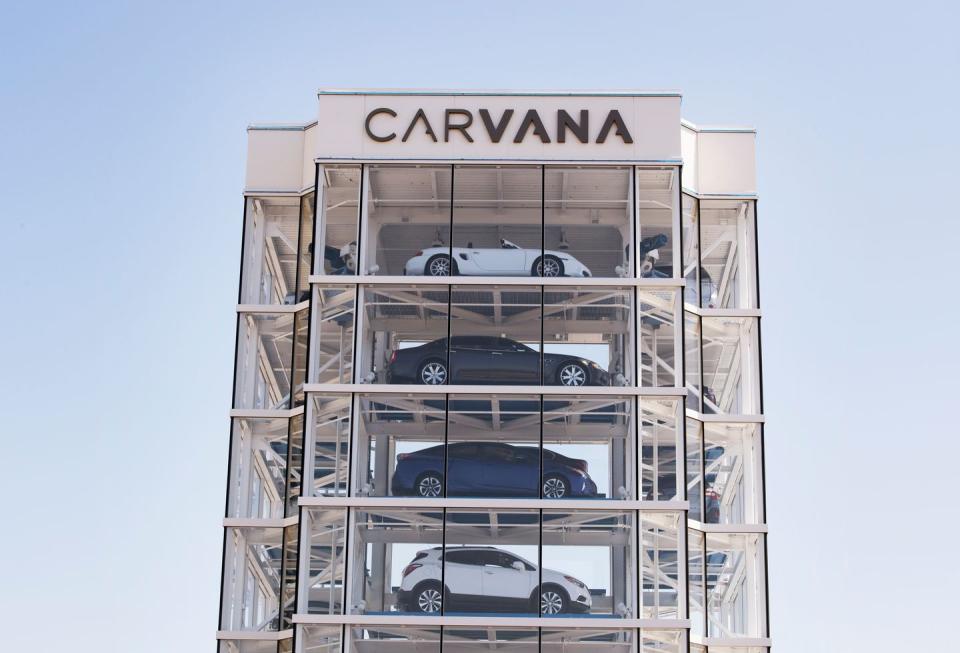Can the Carvana Retail Model Survive? Experts Say Yes

"Hearst Magazines and Yahoo may earn commission or revenue on some items through the links below."
Launched to disrupt the traditional dealership model, Carvana quickly climbed the ranks of online automotive retailers thanks to its upfront pricing and car delivery program.
Reaching its financial peak during the summer of 2021, the company is now in a nosedive, with its stock price dropping by hundreds of dollars and its quarterly reports showing $500 million in losses.
While the demise of Carvana seems imminent, industry experts say the overall company model is one that could succeed in the future, if the right parameters are met.
Once touted as the Amazon of used cars, online retailer Carvana seems to be nearing the end of its formerly successful existence. After posting $400-500 million losses in each quarter this year, the company's stock has been in a free fall without so much as a parachute to slow it down. Additionally, the company has cut 4000 jobs this year, citing concerns over slowing used car sales. With an abundance of inventory, rising interest rates, and record losses, Wall Street analysts are saying Carvana's collapse may be imminent.
But it wasn't always this way. In fact, Carvana was once churning used cars in and out, operating with a simultaneously flowing stream of revenue and inventory. Specifically, Q3 of 2021 showed its first profit, reaching an all-time high share price of $370 and receiving a $63 billion valuation. In theory, that gave Carvana a higher valuation than Ford.

Furthermore, the company was breaking down the barrier of how the industry viewed online car buying. Founded in 2012, Carvana and other dealership-style online services like Vroom or CarsDirect were disruptors in a conformist market. Previously reserved for those brave enough to buy a Craigslist special, online car buying now had the organization of a traditional dealership purchase—financing, delivery, and service included.
If the business model was popular with consumers and had proven itself to be profitable, how did it go so wrong? Diana Lee, co-founder and CEO of Constellation and a former automotive brand consultant, says it's a result of the kind of inventory accumulation that the Carvana model was built on.
Marketed as a painless way to get an instant online offer, Carvana became notorious for carrying through with its online offers, regularly buying copious numbers of used cars from consumers at record prices. When the markets were hot, these units were immediately sold to another consumer in a matter of days or even hours, Lee explained.
"Now, with the interest rates going up and demand falling, they're stuck with these vehicles at record prices," said Lee in an interview with Autoweek. "They don't own these vehicles—they're paying an interest rate for every car that they're holding on to. It's a float of that vehicle, and the float doesn't get paid until they actually make a transaction and sell those vehicles."

This floating finance method of buying and selling cars is common within the dealership realm, but Carvana's fatal mistake was likely in its rapid acquisition of inventory combined with its interest rates nearly doubling. Lee, who previously worked at dealerships and as a business development manager for Ford and General Motors, said the golden rule of the automotive sales industry is to never hold onto a car longer than 60 days.
Past that point, the amount of interest paid and depreciation onset makes selling the car a rarely profitable endeavor. In Carvana's case, its attempt to rival the inventory of traditional dealerships during industry-wide limits on availability means it now has too many cars and too few buyers.

In fairness to Carvana, there was a time when buying excess inventory was paying handsomely. As computer chip shortages surged, traditional brand-based dealership inventory was debilitated and both new and used cars were selling for record high prices at lofty interest rates as demand soared. But this economy of surplus cash couldn't last forever. Inflation has taken its toll on average consumers and businesses in different ways, and Carvana was caught in the middle of a bad storm, Lee explained.
Additionally, Carvana's loan methodology is partially to blame. In fact, a Wall Street Journal article called the company's financing practices risky back in 2021, even at the height of the company's profitability.

 Yahoo Autos
Yahoo Autos